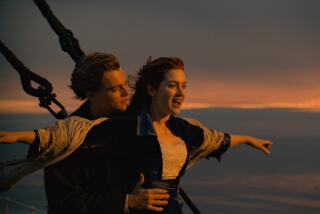Titanic at 100: Books explore many angles of the 1912 disaster
- Share via
The best stories write themselves. That’s what authors often say. And the disaster of the RMS Titanic in April 1912 is one of these, so rich in perspectives and human interest — the social classes aboard, the elegance and technology of the ship, the disaster and missed chances to avert it — that the story seems to unfold with all the doom and precision of a Greek tragedy.
Michael Davie explores all the angles in his “Titanic: The Death and Life of a Legend” (Vintage), a 1986 book reissued for the centennial of the ship’s sinking on its maiden voyage. Davie retrieves simple context for us that’s been easily lost (“People these days are inclined to think that the Titanic was a freak, a huge ship of unique size and luxury. This misunderstanding underrates the scale of the enterprise.”) as well as tackling the myths and scandals in the disaster’s aftermath.
The same is true of Daniel Allen Butler’s “Unsinkable: The Full Story of the RMS Titanic” (Da Capo) and Deborah Hopkinson’s “Titanic: Voices from the Disaster” (Scholastic), both of which apply novelistic turns as they tell the story. In Hopkinson’s case, her book is aimed at young readers, ages 8-12, and provides a wealth of detail but not as much as one finds in Butler’s.
It’s easy to forget — now that ships have water slides, rock-climbing walls and other amusement park frills — just how extraordinary the Titanic’s design truly was. But our sense of wonder is easily restored by the coffee-table-size “Titanic: The Tragedy that Shook the World — One Century Later” (Life Books). Here are photos of the stunning palatial public and private rooms enjoyed by the elite and detailed, cutaway diagrams showing everything from the library and squash racquet court to the smoke room, boilers and third-class berths. There’s even an actual photo of the iceberg believed to be the culprit.
That sense of wonder can also be found in other coffee-table books, including “James Cameron’s ‘Titanic’” (HarperDesign) and Carol King and Richard Havers’ “Titanic: The Unfolding Story” (Quayside), but it’s the Life book that really captures a sense of the Titanic as a microcosm of the world.
John Welshman takes this idea of the Titanic-as-microcosm for “Titanic: The Last Night of a Small Town” (Oxford University Press), which examines the experiences of individual passengers because, he says, “all aspects of society were on the ship, rich or poor, male or female, old or young, generous or selfish.”
The word “selfish” comes up quite often in referring to J. Bruce Ismay, the Titanic’s owner, who was hounded until his death in 1937 because he jumped into a lifeboat with women and children. Frances Wilson’s “How to Survive the Titanic: Or, the Sinking of J. Bruce Ismay” (HarperPerennial) chronicles his life as an outcast, evoking literary allusions along the way. “Ismay is the Ancient Mariner,” she writes, “and he is Joseph Conrad’s Lord Jim, who also jumped from a sinking ship and was forced to live on without honour.”
Though Titanic drama is firmly anchored in nonfiction, fiction writers haven’t resisted approaching it. A realistic, canonical treatment is given by Beryl Bainbridge in a reissue of “Every Man For Himself” (Europa Editions), which follows the experiences aboard of J.P. Morgan’s nephew; much stronger elements of fantasy are part of “The Company of the Dead” (Titan Books) by David J. Kowalski, Jack Steel’s thriller “The Titanic Secret” (Gallery) and William Seil’s “The Further Adventures of Sherlock Holmes: The Titanic Tragedy” (Titan Books), which finds the 19th century’s greatest detective on a secret mission aboard the ocean liner.
If you can read only one book, however, it should be “Titanic: First Accounts” (Penguin), in which editor Tim Maltin gathers classic inquiries and early testimonies from survivors. It is a stunning record of firsthand stories and early reports. “The ship was gradually turning on her nose — just like a duck does that goes down for a dive,” recalls radio operator Harold S. Bride. “I had only one thing on my mind — to get away from the suction.” The book is full of such accounts, as chilling to read today as the North Atlantic waters were on that fateful night.
More to Read
The biggest entertainment stories
Get our big stories about Hollywood, film, television, music, arts, culture and more right in your inbox as soon as they publish.
You may occasionally receive promotional content from the Los Angeles Times.










